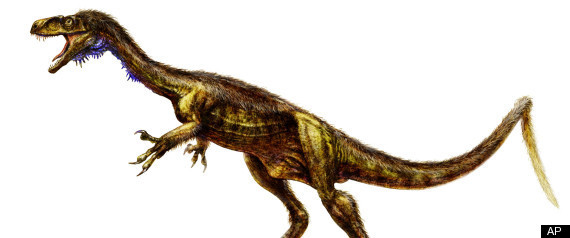
WASHINGTON — Back at the dawn of the dinosaur era, a quick-moving predator set the stage for the famous and fearsome giants that followed in its footsteps, according to new research. "It was a little dinosaur, but it carried a big evolutionary stick," said Paul C. Sereno of the University of Chicago, a leader of the team that discovered Eodromaeus.
The 4-foot-long hunter lived 230 million years ago in what is now South America and appears to be the ancestor of such creatures as Tyrannosaurus rex.
"It is stunning," Sereno said of the find, reported in Friday's edition of the journal Science.
Its features, such as a balancing tail and air pockets in the skull, show it was closely related to T. rex, he said.
But while it stood on two feet like T. rex, Eodromaeus (pronounced eyo-DRO-may-us) was a lightweight at just 10- to 15-pounds.
"This is a very exciting find indeed," said Oliver W. M. Rauhut, a curator at the Bavarian State Collection for Palaeontology and Geology in Munich, Germany.
"The origin and early diversification of dinosaurs is still poorly understood," said Rauhut, who was not on the research team.
Nick Longrich of the department of geology and geophysics at Yale University agreed: "It's very significant, because it helps give us a better idea of what the ancestor of carnivorous dinosaurs – including Tyrannosaurus, Allosaurus and the birds – would have looked like."
"A new species of early dinosaur is always an exciting find, especially when the specimens are so complete, like Eodromaeus," added Randall B. Irmis, a professor of geology and geophysics at the University of Utah.
It shares many features with an early carnivorous dinosaur named Tawa from New Mexico and reported last year by Irmis and colleagues.
The similarity supports the idea that these early carnivorous dinosaurs moved between North and South America during the Late Triassic period, said Irmis, who was not part of Sereno's research team.
In addition to the discovery of Eodromaeus – which means dawn runner – the researchers proposed reclassifying a previously known dinosaur called Eoraptor.
It was similar in size to Eodromaeus, but differences in the teeth indicate Eoraptor more likely was an ancestor of the giant plant-eating sauropod dinosaurs than the hunting theropods like T. rex with which it had been associated, according to Sereno, Paul N. Martinez of the National University of San Juan in Argentina, and their co-authors.
"The reclassification of Eoraptor actually makes perfect sense ... the teeth have always made me wonder," said Longrich, who was not on the research team.
Added Longrich, "this paper helps sort out the origin of several major groups – the big carnivores like T. rex, the birds, and the giant plant eaters like Apatosaurus," formerly known as Brontosaurus.
The new find brings scientists to within a few million years of the original "Eve" dinosaur, Sereno commented. But now the search gets elusive because of the lack of bones below the level where Eodromaeus was found.
Lower, there are footprints but not bones, Sereno said.
The Eodromaeus' fossils were discovered in the late 1990s in the Ischigualasto formation in northeastern Argentina.

0 comments:
Post a Comment